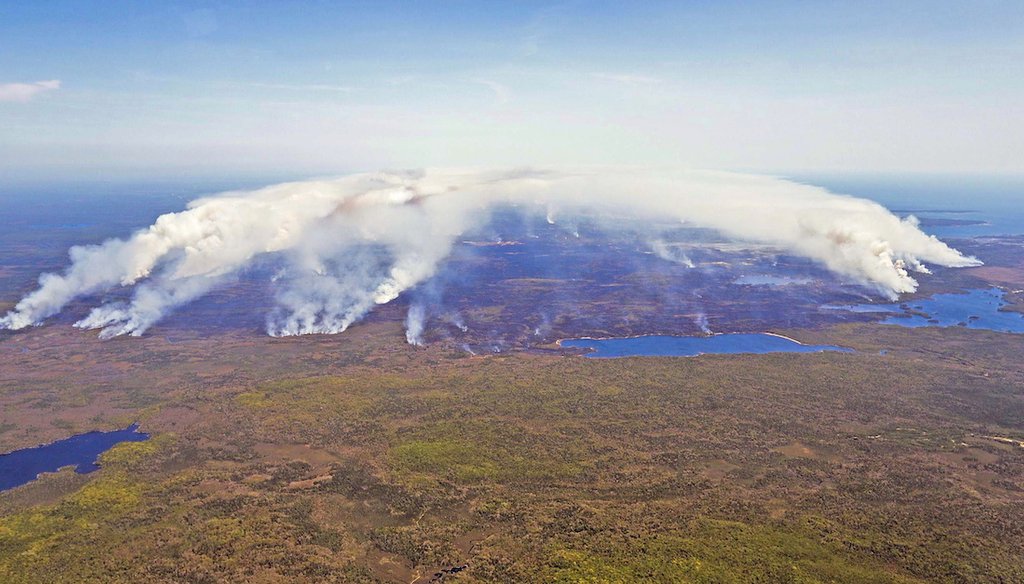



In this aerial image, wildfires burn in Shelburne County, Nova Scotia, on Wednesday, May 31, 2023. (AP)
Canada’s recent wildfires set records for the amount of carbon dioxide emitted into the atmosphere over a short period of time.
But an Instagram post went much further.
"The amount of carbon that wildfires have put into the atmosphere in the last three days is more carbon than what the entire post-industrial human race has put out in the last 100 years," the June 7 post said. The caption said, "You can TRY all that electric car, solar power, zero emissions BS all you want but the facts remain: When Mother Nature is done with us, WE’LL KNOW IT!"
The post was flagged as part of Meta’s efforts to combat false news and misinformation on its News Feed. (Read more about our partnership with Meta, which owns Facebook and Instagram.)
Experts said the claim is wildly off base.
"This is a completely absurd statement that is not based on any facts," said Werner Kurz, senior research scientist at the Canadian Forest Service.
Total emissions from all human activities since 1850 is nearly 10,000 times more than the emissions from Canadian wildfires in 2023, he said.
Carbon dioxide comprises a major share of greenhouse gas emissions, which are produced when fossil fuels such as coal and oil are burned for energy. Most of the world’s scientists agree that greenhouse gases released into the atmosphere from human activity are driving climate change.
"When fossil fuels are burned for energy or used in transportation, they release carbon dioxide – a greenhouse gas that is the main cause of global heating," wrote Kevin Trenberth, a distinguished scholar at the National Center of Atmospheric Research, in a July 2022 article. "Carbon dioxide stays in the atmosphere for centuries. As more carbon dioxide is added, its increasing concentration acts like a blanket, trapping energy near Earth’s surface that would otherwise escape into space."
Chris Field, director of Stanford University’s Woods Institute for the Environment, said 2023 wildfires in Canada have emitted "a tiny fraction of the CO2 released through fossil fuel combustion over the last century — almost certainly less than 0.05%."
Atmospheric sciences professor Andrew Dessler, director of the Texas Center for Climate Studies at Texas A&M University, pointed to another measure.
Human activity over the past century or two has increased atmospheric CO2 from 280 parts per million to 420 parts per million, Dessler said.
"If the Canadian wildfires had emitted as much CO2 as humans did over the past century, atmospheric CO2 would have spiked," he said. "It did not."
Carbon dioxide measurements by the Scripps Institution of Oceanography at the University of California San Diego show no June 2023 spikes.
Robert Brecha, a University of Dayton professor in physics and renewable and clean energy, said climate change is contributing to larger forest fires and longer forest fire seasons, which in turn release more carbon dioxide into the atmosphere, "thus accelerating climate change itself, a positive feedback loop with multiple negative consequences."
We rate the claim that recent wildfires put more carbon in the atmosphere than "the human race has put out in the last 100 years" False.
RELATED: Geoengineered smoke? No. Satellites show smoke that covered northeast US was from Canadian wildfires
RELATED: No evidence wildfires in Canada were set intentionally
RELATED: No, this video doesn’t show that weapons ignited Canada’s wildfires
Instagram, post (archived), June 7, 2023
Axios, "Wildfire smoke is also a carbon emissions problem," June 9, 2023
Email, Kevin Trenberth, National Center of Atmospheric Research distinguished scholar, June 16, 2023
Email, Robert Brecha, professor in physics and renewable and clean energy; and director, Sustainability Program, University of Dayton, June 18, 2023
Email, Werner Kurz, senior research scientist, Canadian Forest Service, June 19, 2023
Email, Chris Field, Stanford University Melvin and Joan Lane professor of interdisciplinary environmental studies and director of Stanford’s Woods Institute for the Environment, June 16, 2023
Email, Andrew Dessler, an atmospheric sciences professor and director of the Texas Center for Climate Studies at Texas A&M University, June 17, 2023
The Conversation, "How not to solve the climate change problem," July 20, 2022
Scripps Institution of Oceanography at the University of California San Diego, "Carbon dioxide concentration at Mauna Loa Observatory, one year ending June 17, 2023," accessed June 17, 2023
In a world of wild talk and fake news, help us stand up for the facts.
